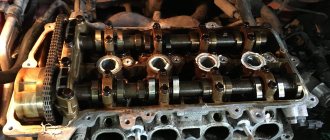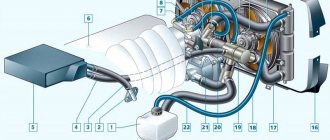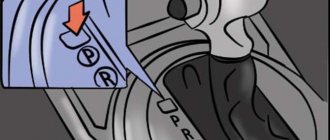There are more and more vehicles with automatic transmission every year, so the number of motorists who are keenly interested in the topic of how best to change the oil is increasing proportionally.
Before starting work, it is recommended to understand how relevant they are for this particular car. Changing the oil in an automatic transmission, full and partial, has its own characteristics for each brand of car.
Many experts differ in their assessments, some believe that the oil needs to be changed more often, others recommend doing it less often. Let's consider this issue in detail.
Preventive actions
When it is necessary to change the oil is not an idle question and depends on the model and brand of the car.
Experienced drivers never neglect preventive maintenance; they always remember what the oil change interval should be. On average, after a run of twenty thousand kilometers, various repairs are carried out.
In particular, a partial oil change is being done in the automatic transmission. The technical fluid is drained by a third and replaced with a new one. This methodology for changing the oil in an automatic transmission produces positive results.
How long it takes to change the oil in the box will become noticeable after a couple of tens of thousands of kilometers. The behavior of the box will tell you exactly when to change the oil in the automatic transmission.
There will be:
- Extraneous noise;
- Vibration;
- The car will no longer be so “spirited”.
All these are sure signs: a period is coming when it is better to change the oil completely.
By the end of this period, its color changes, it becomes much darker.
Which technical center or station will take on such work is decided by each individual
This event will cost at least four thousand rubles, to this should be added the cost of purchasing the product itself.
The work itself is not that complicated, as every average auto mechanic knows how to change the oil.
It should be borne in mind that service station specialists rarely remove the pan, but this must be done to remove any remaining old oil. If this is not done, then when the equipment is running, mechanical microparticles may enter the automatic transmission unit, this will inevitably lead to damage to the solenoids with valves.
Replacing the filter in the box is an important thing. The oil filter also needs to be cleaned or even changed; if this is not done, there will be a lack of oil, which in turn will place additional stress on the bushings and other components. Lack of oil always contributes to rapid wear of parts.
Why so much?
If we take a torque converter automatic or a variator, then the structure of the latter is not as simple as that of its competitors, meaning mechanics and a robot. Both transmissions must be well cooled.
Automatic transmission - here the principle of transmitting torque from the engine occurs thanks to a torque converter. He pulls a couple of liters onto himself, without this there is no way, because the moment will not be transmitted further. Inside the case, there is a set of gears and a pumping station that pumps oil - they also require about 3 - 4 liters. Then the oil circulates inside the closed system, through the radiator and back to the “box”, the radiator and the line take another 2 liters.
Thus, if you add up all the components, you get 2 + 4 + 2 = 8 liters. Of course, this is exaggerated; it all depends on the size of the torque converter, radiator and main hoses. The larger they are, the more ATF fluid needs to be added when replacing.
CVT - almost the same scheme here. That is, there is also a radiator, a line of two pipes, but there is no torque converter here. Torque is transmitted in a different way, namely through a special belt. You can safely take about 1 - 2 liters of oil
However, for the variator in dry terms, the numbers do not differ much, on average about 6 - 7 liters. Of course, the volume may vary depending on power and load.
As is clear, the mechanics and the robot do not have cooling radiators, so they simply do not need such a large volume of lubricant.
What oil to use
When there is a need to carry out a technical inspection of the car, changing the oil in the automatic transmission may be extremely necessary. To determine exactly what technical fluid needs to be filled, it is recommended to call a technical center that services this type of car. The ideal option is if it is an official dealer.
Each automatic transmission needs its own technical fluid.
- As an example, we can say about Mercedes cars, which use a substance produced by the same concern for the oil in the automatic transmission;
- BMW cars use oil produced under the ZF brand;
- Audi or Volkswagen cars use Esso oil;
- Toyota, Nissan, and Lexus fill the automatic transmission with ATF fluid.
- All this costs a lot of money, and therefore there are “replicas” on the market that replace branded products. The cost of changing the oil and purchasing it at a company store may seem excessively high to many.
Table of volumes of popular brands
The highest ATF consumption occurs when the old fluid is mechanically displaced. To calculate costs, you need to add 4 - 6 liters of oil for flushing to the automatic transmission capacity. On average you will need 12 - 14 liters. But if the box is heavily soiled, it can take up to 18 liters!
Read
Do-it-yourself oil change in automatic transmission Skoda Octavia
The method is dangerous for older cars because oil under pressure enters the automatic transmission and washes away dirt from the pan that has accumulated over the years. The slurry flows through the entire box, clogs the filters, screens, and valve body channels, finishing off the already exhausted machine.
Hardware replacement is also not suitable for CVTs and certain automatic transmission models, for example Honda with a fabric filter.
You can change the oil with automatic transmission flushing in another way, namely without the help of equipment and service. The old slurry is drained through the plug in the pan. The pan itself is removed and cleaned of dirt. Change the filter. ATF is poured through the filler tube 1-2 liters more than drained. Warm up the box. Excess lubricant is drained through the radiator return. The procedure is repeated until the oil becomes clean.
The complete replacement method is suitable for all cars and gives high-quality results. ATF is changed at a time. The box is washed from dirt and works more vigorously. The disadvantages include the cost of a large amount of liquid: from 8 to 12 liters.
The most economical method in terms of one-time costs, but questionable in terms of results, is partial replacement. Has no contraindications. The old fluid is drained through the plug in the pan, and then fresh automatic transmission oil is poured in strictly in the amount of the drained volume. The procedure is repeated 2 - 4 times at intervals of 100 - 500 km until the liquid in the box becomes clean. On average, the procedure takes 30 minutes:
- warming up the engine and ATF;
- removing crankcase protection;
- oil drain-fill;
- level check;
- crankcase installation.
Read
How to add and what kind of oil to pour into an automatic transmission with and without a dipstick
The manufacturer indicates how much oil is needed for a partial change in the automatic transmission in the manual. For example, in the automatic transmission of VW Passat B3 (number 096321105) you need to add 3.0 liters. However, fine-tuned 6-, 8-9-speed gearboxes do not need to be serviced according to regulations. There are no instructions on the volume of partial oil filling. The manufacturer refers to the preservation of the operating properties of ATF throughout the entire service life of the automatic transmission. Namely, until the first overhaul of 150 - 200,000 km.
In real operating conditions, ATF ages by 60,000 km, so it needs to be changed in order to extend the life of the automatic transmission and delay major repairs. The table shows oil volumes for partial and complete replacement of the most popular car brands, taken from service practice.
Read
Automatic transmission oil Mopar ATF 4
| car model | Automatic transmission type | ATF volume for partial replacement with pan removal, l | ATF volume for complete replacement with flushing, l |
| Chevrolet Aveo (T300) | 6T30 | 4,5 — 5,5 | 8,0 — 12,0 |
| Chevrolet Cruze | 6T30, 6T40, 6T45 | 4,5 — 5,5 | 8,0 — 12,0 |
| Ford Focus 2 | 4F27E | 3,5 — 4,0 | 8,0 — 12,0 |
| Honda CR-V | M4TA, MRVA | 3,0 — 4,0 | 6,5 — 8,0 |
| Hyundai Accent | A4AF3 | 3,5 — 4,0 | 8,0 — 12,0 |
| Hyundai ix35 | A6MF1 | 4,0 — 5,0 | 7,5 — 12,0 |
| Hyundai Solaris | A6GF1/2 | 4,0 — 5,0 | 7,5 — 12,0 |
| Kia Rio | A6GF1/2 | 4,0 — 5,0 | 7,5 — 12,0 |
| Mazda 3 | FN4A-EL, FNR5 | 3,5 — 4,0 | 7,0 — 12,0 |
| FW6A-EL | 4,5 — 5,0 | 9,0 — 12,0 | |
| Mazda 6 | FN4A-EL, FNR5 | 3,5 — 4,0 | 7,0 — 12,0 |
| FW6A-EL | 4,5 — 5,0 | 9,0 — 12,0 | |
| Nissan Almera Classic | RE4F03A | 4,0 — 5,0 | 8,0 — 12,0 |
| Nissan X-Trail | JF011E (CVT) | 5,5 — 6,0 | 8,0 — 10,0 |
| JF613E | 4,5 — 5,5 | 8,0 — 12,0 | |
| Opel Astra H-J | 6T30, 6T40 | 4,0 — 4,5 | 8,0 — 12,0 |
| Toyota Camry | U250 | 3,5 — 4,0 | 8,0 — 12,0 |
| U760 | 4,0 — 5,0 | 8,0 — 12,0 | |
| Toyota Corolla | U340 | 4,0 — 5,0 | 8,0 — 12,0 |
| Toyota RAV4 | U250 | 3,5 — 4,0 | 8,0 — 12,0 |
| U760 | 4,0 — 5,0 | 8,0 — 12,0 | |
| Volkswagen Jetta | 09G | 3,5 — 4,0 | 8,0 — 12,0 |
| Volkswagen Passat B6 | 09G | 4,0 — 5,0 | 8,0 — 10,0 |
| DQ250 | 5,0 — 5,8 | — |
Read
Transmission oil for automatic transmission Mobil ATF 3309
Partial oil change in automatic transmission
There are two types of professional automatic transmission oil changes:
- Using the device;
- Manual.
The first is done in branded technical centers using the most modern technology. The second type is cheaper and therefore more attractive.
A partial oil change in a machine is also often practiced; this procedure has both positive and negative properties.
First of all, you don’t need to contact a car service here, you just need an equipped garage. A necessary technical fluid that will have to be added to maintain a high oil level. The risk here is low, the technology is simple, so this method is common in Russia.
The negative side here is that such operations will have to be done more than once. Change the gearbox oil one hundred percent
It’s unlikely to work, the maximum you can count on is 30-40%. Adding oil should be repeated after a certain mileage, this should be repeated at least four times. However, a 100% automatic transmission oil change is impossible.
Partial oil changes are widely practiced on many brands of cars; you can watch a video on how to add oil to a box on the Internet:
- The pan is unscrewed;
- Oil that has already been used is drained;
- The pallet is mounted in the old place;
- New oil is added.
With this methodology, we see that the technical fluid in the automatic transmission is partially and sometimes completely renewed. The oil level in the box is restored, but it is worth considering: the remains of old oil in the oil compartment remain small.
How many liters of oil are needed for the automatic transmission of a Toyota Corolla?
Changing the oil in a Toyota Corolla automatic transmission requires a minimum of effort and available tools. This car is quite easy to repair and maintain independently. Moreover, if we are talking only about replacing consumables. In this article, we will look at how to choose the right consumables, what is the frequency of replacement, and also how much oil is required for a Toyota Corolla automatic transmission.
Regulations
The Japanese automaker has established clear regulations for changing the oil in the Toyota Corolla automatic transmission. It is about 60 thousand kilometers, but may differ for the worse depending on operating conditions. So, if the machine is not subjected to high loads, is operated in warm climatic regions and travels on high-quality roads, then you can rely on the maximum replacement period. But the situation can become more complicated if the motorist encounters unpredictable weather and road conditions. Let's highlight a few of them:
- A sharp change in temperature, frost gives way to thaw, and as a result - dirt and slush on the roads
- Driving on bad roads, including off-road with muddy ground
In such conditions, transmission oil will become unusable faster than the replacement period of 60 thousand kilometers. Russian motorists are well familiar with such factors, who prefer to reduce replacement to 40 thousand kilometers. In extreme cases, it is necessary to change the oil after 30 thousand if the driver makes mistakes in driving the car - for example, constantly exceeds the speed, does not work correctly with the gearbox and clutch, and as a result, overheating of important components occurs. But on the other hand, sometimes you have to subject the car to extreme loads, given difficult climatic and road conditions
But here it is important to keep in mind that in such a situation you will have to resort to changing the oil more often. Moreover, it is advisable to frequently monitor the volume and condition of consumables
How to check the volume and condition of the oil
Toyota Corolla is equipped with a dipstick with special marks. They can be used to determine whether there is enough oil in the gearbox. For example, if the fluid is below the minimum level (Min), then oil will need to be added. At the same time, it must be added gradually, avoiding overflow. Otherwise, you will have to crawl under the car and drain the liquid. To achieve the optimal level, it is necessary that the oil is no higher than the maximum mark (Max) on the dipstick.
It is important to understand that the procedure for adding oil is only relevant for cars with low mileage, or if the oil is changed in a timely manner. But if you do not follow certain rules and expose the car to high loads, as written above, you may encounter unpredictable breakdowns in the gearbox
In such cases, the oil has most likely completely lost all its beneficial properties. As a result, the transmission is unstable and constantly overheats. Four signs indicate that the oil is unsuitable: darkened color, cloudiness, presence of sediments and metal shavings. In addition, spoiled oil can emit specific odors. If such signs are detected, the old oil should be drained immediately.
Choosing oil for automatic transmission Toyota Corolla
Before adding new oil, you must make sure that this product meets all the parameters specified in the instructions. In other words, the oil must be fully compatible with the Toyota Corolla automatic transmission. Therefore, in order to avoid mistakes in the selection process, you must rely on the manufacturer’s instructions. For example, you should only fill in original Toyota ATF Type T-IV oil. This product has optimal viscosity parameters and is designed for a long service life. As for the type of oil, in our case only synthetic is suitable. It is recommended to fill in semi-synthetic oil only with high mileage, or in case of lack of funds for expensive synthetic oil.
How much to fill
Toyota requires 4 liters of transmission fluid to be poured into the Corolla automatic transmission. This volume is the maximum and can only be entered during a complete oil change. During this procedure, the old fluid is first drained, then a flushing agent is introduced, which is circulated throughout the entire transmission with the engine running. The flush is then drained along with any dirt and metal shavings that may have gotten inside through a clogged oil filter. The final stage is filling the new oil in full. The level is adjusted to normal using a dipstick.
Pros and cons of partial replacement
Benefits from such technology:
- The operation itself does not present any difficulties;
- It is not necessary to have qualifications as a car mechanic; it is enough to be able to hold a wrench in your hands;
- Precious product is used sparingly;
- From the remains of old oil, you can determine: what condition is the internal mechanism of the automatic transmission;
- There is virtually no possibility of damaging the structure of the box.
Negative sides:
- A complete oil change cannot occur with this technology;
- This must be done repeatedly, this increases additional costs.
It can be summarized that such methods are used in certain cases, for example, when buying a used car with high mileage. Also, when there are any malfunctions in the automatic transmission, for example, the box regularly heats up.
Complete automatic transmission oil change
It is almost impossible to completely change the oil in an automatic transmission with your own hands; you should contact a service center, where during operation you must strictly follow the technological sequence of all processes
An oil change at a service center is done using an effective tool
and special equipment.
The algorithm of actions is as follows: A new product is poured in the same volume as was received. A complete oil change can only be done using good, modern oil change equipment. Wealthy car enthusiasts can afford to use this technique to change the oil. Therefore, a technology called the displacement method is very often used.
When changing the oil can harm the automatic transmission
The automatic transmission is designed in such a way that sometimes changing the lubricant can harm its operation. This is due to the fact that during the operation of the automatic transmission, wear products of parts that come into contact are formed in its cavities. Metal shavings accumulate over time and settle on the internal surfaces of the unit. Compared to used oil, new oil more actively washes away such sediment, and it soon ends up in the valve body, causing blockages. In the zone of such risk are boxes of cars with high mileage, in which the oil has never been changed (or has been done for a very long time). Therefore, when updating the lubricant in an automatic transmission, you should approach it carefully and choose the method that is best suited for a particular case.
Do-it-yourself oil change
To change the oil yourself, you definitely need a companion; it is not possible to do such an undertaking alone.
Before starting the operation, you should warm up the car and drive a few kilometers. Then the car drives into an equipped garage and the operation of replacing the transmission gearbox begins.
- The plug is removed;
- The pallet is dismantled;
- The filter is removed;
- Both the pan and the filter carefully drain the remaining old oil;
- All surfaces and components are wiped and washed with gasoline;
- The same amount of oil is poured in as was removed;
- The tubes are removed from the radiator;
- Instead of tubes, corresponding hoses are attached to the radiator;
- The free ends are directed into a container where the liquid will drain;
- Your partner should turn off the engine as soon as the liquid becomes clear.
- After completion of the work, all parts are returned to their original place.
Negative sides:
- You will have to use the same amount of oil, maybe even a little more;
- There is a risk of incorrect actions;
- Separate difficulties are presented by such machines as;
- Ford;
- Nissan;
- Mazda.
They do not have drain plugs, so to change the oil you must not only remove the pan, but also change the gasket.
Positive side:
- Significant savings in money;
- A complete oil change should be done after a mileage of fifty thousand kilometers;
- If you do not follow the instructions, the box will begin to sound poorly, operate poorly, and make strange noises. This is a sure sign that most of the parts are actively wearing out and have only a short time left to work.
You should follow the recommendations for operating automatic transmissions, then many problems will be eliminated in a working order.
About replacement and how much to fill
Now, probably many can say: “When I replaced it, they only changed 5 liters.” The thing is that you can change ATF fluid in different ways. Not all automatic transmissions or CVTs can be disassembled. Therefore, the lubricant is simply pumped out from above using a special pump, but this also happens in two steps:
If your machine does not have a drain plug (or there is no pan for removal), the service station will pump out the oil through the filler neck. But the whole problem is that the master can’t reach the bottom, so 5 liters are pumped out. dirty grease, but you still have about that much left inside.
Then the technician adds new oil to you and you drive for a while, then, say, after 500 kilometers, you again come to the service station, where they drain half of it again and fill you with the same amount of new oil.
Thus, in two doses, 80–90% of the fluid is changed, although this is not entirely correct. That is, in any case, you will fill in about 10 liters, that’s just how it will be done! Some of the dirty ATF fluid will still remain. So it turns out that you changed 5 liters, but after a certain mileage you will return again.
It is worth noting that the most correct replacement is when you remove the pan (or disassemble the machine), then drain the old “liquid”, change the old filter, clean all the pans, magnets and then fill in new oil. This is how the replacement should be done.
When is it too late to add oil?
It’s time to sound the alarm if there is a sharp clouding of the oil; a microscopic suspension of mechanical particles is visible at the bottom of the vessel.
This is the surest sign that an oil change should be done urgently.
If particles larger than one millimeter are observed on the magnets of the pallet, then major repairs should be done immediately, because there is evidence of destruction of the units from internal excessive loads.
If there is only a coarse filter, then after a couple of tens of thousands of kilometers the rings and gaskets will be significantly worn out, and the oil will darken.
A sure sign that destructive processes are occurring in the automatic transmission is the presence of the smell of burnt oil. In this case, various crumbs of particles appear:
- Metal;
- Plastic;
- Brass.
There are only two options here:
- Prompt sale of the car;
- Expensive transmission repairs. The second option may not be economically feasible if the car is no longer new
Oil in multi-stage gearboxes
Automatic transmissions from 4 to 8 shift stages are the most complex devices in a car. Such blocks are controlled only by electronics; chips that control the controller are connected to the blocks.
The indicator is displayed on the dashboard. The latter, in turn, changes its operating modes as the physicochemical properties of the working fluid change.
The oil temperature when the engine is running is more than a hundred degrees, so sometimes multi-stage automatic transmissions can malfunction, especially when it comes to:
- Plastic valves;
- Electrical board
Automatic transmission selector sensor
The selector lever sensor provides the driver with information regarding the operation of the automatic transmission. The sensor reports data:
- Controller;
- Controls the starter;
- Manages reverse signals.
The sensor is attached to the automatic transmission shaft. A malfunction of this device causes the entire automatic transmission to malfunction. A particularly vulnerable part of the sensor is its contacts, which sometimes become frayed and cause false information to be reported.
The box selector is a reliable conductor of information between the car and the driver, so preventive inspection of this device is also very important.











